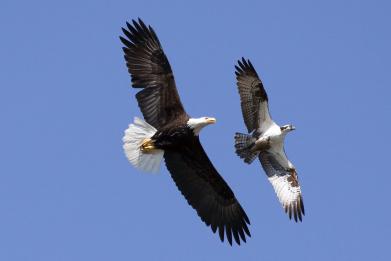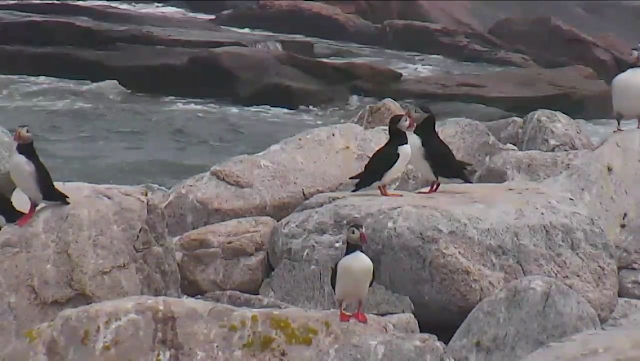Here's a photo showing the relative sizes of eagle and osprey:

No contest. But actually what happened was just a sneaky snatching of the young ospreys from the nest when the parents were absent.
There's a short video of the catastrophic (to the ospreys, not the eagles) event:
Audubon’s Steve Kress Provides Insight on Osprey Chicks
The Hog Island Osprey Nest and its viewers were shocked on Friday when an eagle
took both young osprey chicks from their nest in the afternoon hours. Project
Puffin Director Dr. Steve Kress provides his insight and gives context on why
the eagle attack may have occurred, including a first hand account from staff on
Hog Island.
“I share the loss of our little osprey chicks
‘Big’ and ‘Little’ who vanished today so suddenly. I too will miss watching the
daily drama at the nest unfold. But now we must look for new lessons in this.
What will Rachel and Steve do? Will they continue to frequent the nest and guard
it from intruders? Will they take this opportunity to do some remodeling by
building up new layers of nesting material in anticipation of next year? My
hunch is that they will not lay eggs- there would not be time before the
powerful urge to migrate lifts them into the wind. I long ago learned that
watching birds is endlessly surprising and with the tool of the cam, we all have
the opportunity to learn together.
We do know for sure that it was an eagle that
took the chicks. And we have an eyewitness account. The Hog Island chef had just
stretched out in a nearby hammock to take a well-deserved rest when she heard
the ospreys calling loudly- then heard a loud ‘whoomphing noise.’ She turned to
see the eagle flying low to the ground and suspects the eagle was hit by one of
the ospreys-and this drove it to the ground. ‘The eagle looked as though it hit
the ground and had trouble gaining altitude, but barreled off through the trees,
right by my hammock.’
This is the first time that an eagle has
snatched nestlings from Rachel and Steve, though eagles and Great Horned Owls
have threatened the nest before. Much of the ospreys’ success up to today is
because their nest is located in the center of the Hog Island Audubon Camp.
When it is in session, the camp provides protection as there are usually bird
watchers frequenting the vicinity. Rachel and Steve have grown accustomed to
this activity which usually deters wary eagles. However, the 50 participants in
this week’s program ‘Hands on Bird Science’ departed this morning, which may
have given the eagle an opportunity to attack. A pair of eagles also nest on Hog
Island in a nearby giant white pine and they have at least one chick to feed.
But today’s attacker could have just as easily been a random bird taking
advantage of an opportunity. Maine’s coastal Bald Eagles often feed on other
birds, though these are usually gulls and sea ducks such as eider. And eagle
populations are on the increase- an indication of less pollution from pesticides
such as DDT. The most recent Maine statewide eagle census found more than 700
pairs–a dramatic increase from only a few pairs in the 1960’s.
It’s natural to look for meaning and lessons in
such a loss- and though it’s tough to witness, I reflect that some birds will
live as others pass. And this is very much the case with eagles. Each bird is
just trying to stay alive and rear its young. Today’s drama reminds us how
beautifully adapted each animal is to its habitat and home. This cam has given
us a remarkable window to see nature as few have seen it
before.”
Moving on, now there's a new (to me) webcam: puffins in Maine.
How cute are these little guys!
Barely big enough to cover the egg.
There's even a webcam outside the burrow where we can watch the behaviour on land of these amazing little birds that spend their entire lives at sea, coming ashore only to raise young.





No comments:
Post a Comment